Living
Tucson Modernism Week

Photo: On Saturday, October 10, 5pm, join Architect Dino Sakellar (son of Nicholas Sakellar) for an exploration of the life and work of one of Tucson’s iconic mid-century modern architects. The son of Greek emigrants Nicholas and his bride, Phyllis, moved to Tucson soon after World War Two. Over his 50 years of practice he created many of Tucson’s most beautiful buildings. He is one of three architects credited with bringing modern architecture to Tucson.
Exploring Tucson’s Mid-century Design Heritage
After four years, jam-packed schedules and a slew of innovative lectures and events, you’d think the organizers of Tucson Modernism Week might start running out of ideas.
Not so. This year’s Tucson Modernism Week is busier than ever, the line-up arguably its most impressive to date.
That’s due in large part to the small army of volunteers behind the nine-day event. And it’s due in equally large part to the stories that abound here in Tucson, says Demion Clinco, Chief Executive Officer of the Tucson Historic Preservation Foundation, which organizes Tucson Modernism Week.
“I think that Tucson was definitely an epicenter of design in Arizona and regionally and in some ways nationally and we don’t give our community credit for that,” says Clinco. Added to that is the fact that retirees who settle here bring with them their own “incredible” stories, he says.
In fact, the more Clinco and his team digs, the more fascinating tales of mid-20th-century Tucson it uncovers. Some of those stories take longer to emerge than others, however.

1950s western wear dresses by Tucson based Dolores Gonzales (Dolores Resort Wear), a special exhibit of Tucson Modernism Week. Image courtesy of the Dolores Gonzales Family Collection.
Clinco first spotted the 1950s dresses of fashion designer Delores Gonzales in archive materials more than a year ago. It took many months and some detective work to locate her remaining family, now living in Colorado and California. That set in motion the creation of a fashion exhibition of Gonzales’ western wear, to take place in the lobby of the Tucson Convention Center on October 3rd and 4th.
Delores Gonzales was born in Sonora, Mexico in 1907. In 1914, at the age of 7, she moved with her family from Agua Prieta to Douglas, Arizona. The story goes that a bullet from a Pancho Villa raid had landed on Delores’ pillow. Her father said “Enough” and moved the family over the border. Gonzales learned her sewing skills from her mother Beatrice and honed them in Los Angeles where she was a pattern cutter. Bad asthma forced her to return to Tucson where she owned a factory and a store.
“She was quite well known in Tucson and societal circles,” says Bob Gonzales, Delores’ younger son, who with his brother Leo used to roll braid and rick rack in the factory as a child.
She was also influential in the fashion world. “Cele Peterson credited her as being a major component of the whole movement of patio and western dresses,” says Clinco. This “Tucsonan chic” style – which incorporated the colors and Native American influences of the southwest – was picked up by national department stores. Says Clinco: “There’s no one person who you can credit but [Delores] comes as close as you can get.”
“I think that it’s overdue,” says Dolores’ daughter-in-law Karyl Gonzales of the Tucson Modernism Week exhibit. “She more than won any accolade anyone ever gave her.” Karyl, who will attend the event, remembers Dolores as a “party girl, party giver and party goer.” She first set eyes on her future mother-in-law at a function at the Pioneer Hotel on Stone Avenue. “She had white hair pulled back in a bun. She was wearing a black gown. I thought she was the most beautiful woman I had ever seen,” says Karyl.
Karyl married Dolores’ son Leo (known as Lee) and she and Dolores bonded over fashion; Karyl studied theatre at the University of Arizona and went on to work in costuming. Karyl and Lee’s daughter Lisa Marie Gonzales – whose childhood wardrobe was filled with outfits Dolores made just for her – carries on the fashion legacy. Lisa Marie now owns the fashion line DCC Diversified Clothing Company in California.
Fashion is a strong theme of this year’s Tucson Modernism Week. Ted DeGrazia’s textile designs will be on show at the DeGrazia Gallery in the Sun, while the closing party is a 1965 fashion show and silent disco at the 1965-built Murphy Wilmot Library.
Other Tucson Modernism Week highlights include: a furniture and home goods expo at the Tucson Convention Center; a mid-century modern home tour featuring buildings by Arthur Brown, Louis Coon, Nicholas Sakellar and William and Sylvia Wilde (and special lectures on architects Nicolas Sakellar and William and Sylvia Wilde); and the annual vintage trailer show.
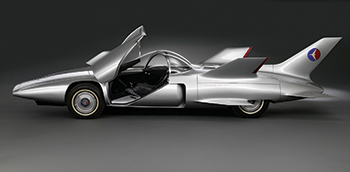
Firebird III GM Concept Car. Image courtesy GM Media Archives
One of the stand-out events will take place at MOCA Tucson: the arrival of the Firebird III [see sidebar]. This futuristic concept car was developed by General Motors in the 1950s as part of a series of car designs that were never intended for production, but rather to showcase just how far GM could go with its technology and design.
The car barely leaves its home at the General Motors Heritage Center in Sterling Heights, Michigan. On October 3rd, thanks to a collaboration between Tucson Modernism Week, the General Motors Heritage Center and insurance firm AIG, it will be on display for one weekend only at MOCA. Also present will be two of its designers, Norm James and Tucsonan Jim Ewen – reunited for the first time in more than 50 years.
The significance of the Firebird’s journey to Tucson isn’t lost on Thom Sherwood, a local Pontiac enthusiast and volunteer for Tucson Modernism Week. “It’s as if someone were to ask the Louvre in Paris to send the Mona Lisa to a backyard barbecue in Podunk, Arkansas. It’s a testament to the respect that GM feels towards its legacy and their designers, that it is undertaking to get the car shipped just for the weekend,” says Sherwood, who as well as moderating the Firebird III lecture, is overseeing a show of vintage “finned” cars outside the MOCA building on the same day.
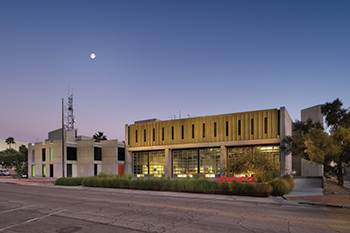
On Saturday, October 10, 3pm, join Demion Clinco for a look at the Architectural Work of William and Sylvia Wilde, pioneers of Modern architecture in Tucson, and designers of Tucson Police & Fire Departments, built in 1974. Photo by Garardine Vargas
Fun and fins aside, the organizers of Tucson Modernism Week hope their annual event does more than entertain. Its mission is “to educate the community” about the mid-century period and its renaissance, says Clinco. Volunteers try hard to hold their events in mid-century modern spaces. Architects who did influential work here in the middle of last century, but are not widely recognized for it, are celebrated. Clinco says that since Tucson Modernism Week began he sees the Tucson community taking more notice of the city’s mid-century buildings – some of which are hidden in strip malls. “Three years ago we didn’t see that happening. That makes me really thrilled. I’m confident people will be a little bit more conscious about mid mod design and not just cover it up with stucco.”
Last year’s Tucson Modernism Week pulled in 4,000 to 5,000 people, says Clinco, up from 3,000 the previous year. He reports ticket sales from the East Coast, Texas and even London. So why all the interest in the middle of the last century?
For one thing it was an exciting time in design, says Alan Hess, a Los Angeles historian, Tucson Modernism Week speaker and author of Googie Redux: Ultramodern Roadside Architecture. “The mid century period of the 20th century was a time of experiment and really talented architects [who moved] in a lot of different directions. The sunbelt generally was booming, people were moving there, there was development going on that attracted architects,” says Hess, whose lecture Modernism’s Back takes place at MOCA on October 3rd.
In the Arizona desert in particular, architecture was also functional, he says.“Modern architecture was about solving a problem. It was very very practical, especially when you were building a house in the desert and you have the sun coming into the house, the heat, the soil. All these things shaped the house.”
Luckily for Tucson and its mid century heritage, the Mad Men era is, quite simply, in vogue. Says Hess: “Every architecture style goes through its cycle. It’s new and then it gets to become old fashioned. It might get torn down, it gets rediscovered. It might take 30 to 50 years and it’s re-appreciated. This is just modernism’s time.”
For tickets and a complete schedule of Tucson Modernism Week happenings, please visit TucsonMod.com
George Mumford in Tucson – Wed, April 8
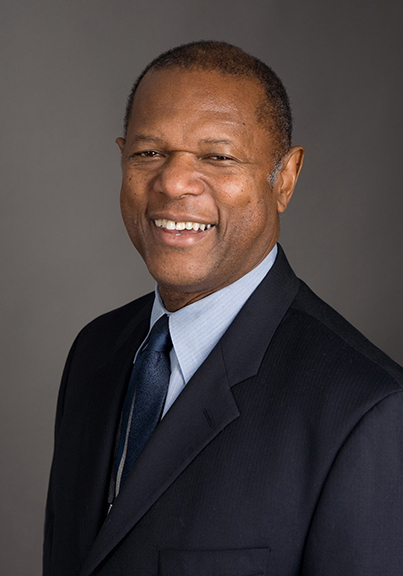
George Mumford
UA’s Confluencenter for Creative Inquiry is bringing George Mumford – sports psychologist with Phil Jackson and meditation teacher/coach renowned for enhancing individual and team performance though mindfulness meditation – to Tucson to deliver several free public lectures on Wednesday, April 8.
At 3 p.m., Mumford speaks on the theme “Learning to Play, Playing to Learn” at El Pueblo Neighborhood Center, 101 W. Irvington Rd. This free talk, geared toward youth but applicable to all, focuses on simple and powerful methods to achieve your aspirations.
At 7 p.m., Mumford presents “Pursuing Excellence with Grace and Ease” at UA’s Gallagher Theater, 1303 E. University Blvd. The free presentation is centered on how to utilize mindfulness meditation as a key to success.
As an athletic trainer, mentor for at-risk youth and motivational speaker, Mumford urges his diverse clients and audiences to practice meditation as a means of developing concentration, focus and mental toughness. Mumford is best known for working with the Chicago Bulls and Los Angeles Lakers during their championship seasons in the late 1990s and early 2000s.
Mumford’s proven techniques can transform the performance of anyone with a goal – be they an athlete, student, academic, executive, musician, hacker or artist. Mumford shares his story and strategies in his Tucson talks, topics being covered in his forthcoming book “The Mindful Athlete: Secrets to Pure Performance,” set for release by Parallax Press this May.
By hosting George Mumford, Confluencenter continues its mission to sponsor engaging and free programming that examines humanity’s grand challenges.
“The eclectic nature of Mumford’s talks, which include elements of cognitive science, sports medicine and Eastern philosophy, represents the innovative and interdisciplinary work in which Confluencenter invests,” explains Confluencenter for Creative Inquiry Director Dr. Javier Duran. “We are excited to bring Mr. Mumford to Tucson to speak to both the UA and broader Tucson communities.”
Mumford’s community presentation at El Pueblo Community Center is possible through in-kind support from Ward I Councilor Regina Romero’s office. Mayor Jonathan Rothschild is also offering his support by being a part of the El Pueblo Community Center talk. Call 621-4587 or visit Confluencenter.arizona.edu for more information.
The Downtown Clifton
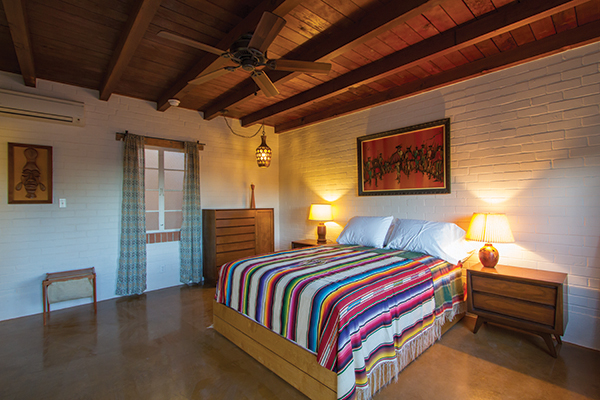
The Downtown Clifton
Clif Taylor is Tucson through-and-through. For starters, he was born and raised here, and one of his first concerts was actually an Elvis show at the TCC. Thanks to an interest he shared with his father growing up, he’s on a first-name basis with some of Mexico’s most famous bullfighters and, whether you know it or not, Taylor has put his own personal touch all over downtown Tucson as a designer for businesses like Hotel Congress and Maynard’s Market. Since he’s essentially been brought up 100 percent Sonoran, his style absolute reeks of that dusty, funky, kind-of-run-down-but-loved-to-death feel that typifies this city, especially in the way it seems to impress those visiting from out of town.
Perfect, then, that Taylor’s most recent project caters directly to that clientele—a type that Taylor himself identifies as “the adventurous traveler”. The Downtown Clifton at 16th St. and Stone Ave.—set to hold a public soft-opening event on the evening of March 28th—is a single-story ten-room motel that is tucked unassumingly onto a less-than-half-an-acre lot on the eastern edge of the Barrio Viejo neighborhood. Owners Phil Lipman and Moniqua Lane purchased the property from a private owner for $550k in October of 2013 and, for several months, they weren’t quite sure what to do with it.
Lipman says that, since there is a major housing shortage in downtown and South Tucson, his initial idea was to demolish the current building—a rather plain brick structure which had a former life as assisted housing—and install a much denser three-to-four story apartment complex on the site. But when the neighborhood reacted negatively late last year to a proposal to demolish the Downtown Motor Lodge with intentions of building something similar in scale to what Lipman and Lane had planned just two blocks north of the Clifton, the business partners had a change of heart. “We decided it would probably be better, rather than knock it down, to instead do something cool with the original building,” says Lipman. And, with an eye on the apparent interests of the other residents of Barrio Viejo, Tucson’s newest retro-chic motel was born.
Lane says that when she and Lipman first purchased the property, both of them wanted to stay clear of the hotel business. But after deciding to keep the original structure intact —and it was apparently in alarmingly good shape—the idea of getting into hospitality in downtown Tucson simply started to grow on them. When Taylor expressed an interest in taking charge of the project’s over all aesthetic, the two co-owners quickly gave him carte blanche to make the property into a vision all his own. The result, says Lane, “captures that real dusty-dirty feel” of the city without sacrificing on comfort.
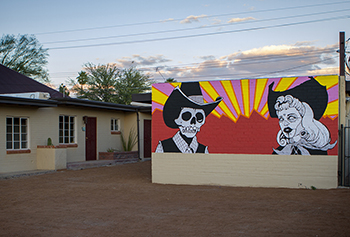
Mural by Danny Martin
Each room of the “twisted mid-century bunkhouse” is specially curated with “a million little weird details,” according to Taylor, including a great deal of art from his personal collection, swag lamps, custom-made platform beds, and even a mini-fridge, AC split, and flat screen TV for that all-essential touch of today required by the average modern tourist. The original colored concrete floors of the building were exposed in each room, the bathroom tiles and rafter ceilings preserved, and a number of brick planters, a fresh coat of paint inside-and-out, and a large full-color mural by local artist Danny Martin were added to give the property a certain border-town charm. Rooms at the Clifton will start at around $100 per night, though since there are only ten, chances are good that the place will fill up fairly quickly, especially during the busy season.
One more touch that promises to give the Downtown Clifton a slight advantage over would-be competitors in the area is the presence of a live-in manager and concierge in Liz Fogel. Fogel is also a Tucson native, though she spent a short spell in Austin, and the fact that she will be on the hotel grounds and in downtown in general full-time means guests can make use of her knowledge of the area and enjoy a completely customized downtown experience which caters to their specific tastes. “It’s like the tour of downtown Tucson that you would give your family if you were able to get off work,” says Lane. No doubt many locals will appreciate that sentiment—after all, that’s one less thing to worry about when the in-laws come to town.
The Downtown Clifton is located at 485 S. Stone Ave. More info on the hotel, booking rooms, and upcoming events can be found at TheDowntownClifton.com
Downtown’s Shifting Landscape
All progress is precarious, and the solution of one problem brings us face to face with another problem.
– Dr. Martin Luther King, Jr.
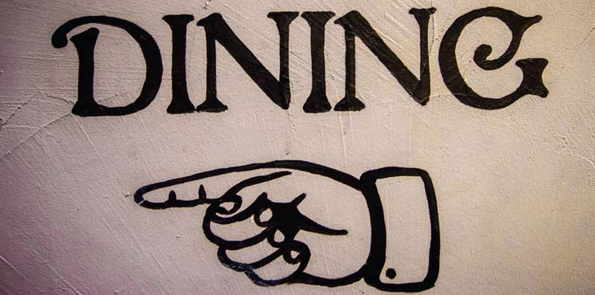
Directional sign at Maynards Market. photo: David Olsen
In the mid-‘80s and through the ‘90s and early ‘00s, Downtown was considered a schlumpy locale eschewed by seemingly many Tucsonans. It was the artists, musicians, the writers and photographers, galleries, bars, a handful of entrepreneurs, restaurants, long-established families, some smart investors and renters who comfortably called it home. The cheap rent and authentic vibe drew those to the area.
As progress happens, so does construction, such as the 4th Avenue underpass and the streetcar tracks. Congress Street, as was the revitalization goal, is a different place than it was five years ago. Only a handful of pre-2009 businesses along that strip remain.
Today, Congress Street is certainly a destination for food and drink. It’s not a destination for the arts, the galleries mostly ring the northern edge of Downtown in the Warehouse District. Three galleries that were in the Downtown core are leaving or have left: Sacred Machine, 245 E. Congress St., Atlas Fine Art Services, 41 S. 6th Ave., and Obsidian Gallery, 410 N. Toole Ave.
For Sacred Machine’s proprietors, Paula Catherine Valencia and Daniel Martin Diaz, closing shop isn’t related to the Downtown economy or foot traffic. Theirs is a career move to L.A. However, Paula’s observation was this: “If you want to know what challenge might be happening with galleries down here is that it’s not necessarily a walking destination like 4th Avenue. You know, people go there, they walk, they’re used to looking through shops and hanging out. Their main thing isn’t to eat and drink there. When all that you have Downtown is restaurants and bars, people are here for lunch and dinner and to party later at night. Their agenda is to eat and drink, their agenda is not to shop and browse. So that becomes a different thing all together. I think that’s what’s happened with Congress Street.”
With Atlas Fine Art Services, which opened in August 2011 when Downtown was gaining traction with new restaurants—which would presumably help with foot traffic—it was difficult to gain traction themselves and they closed earlier this year.
Co-owner James Schaub wrote via email, “Foot traffic was something we hoped for and would have been helpful—but it never came. The foot traffic that happens Downtown is still much the way it used to be—people park as close as possible (increasingly harder to do) to where they want to go and go to that place and then drive to the next place. Our business, and others like it, is more of a destination. We usually knew when people were coming in—they called in advance. The students who now live Downtown are similar, most have cars and there is no real retail culture yet in the Downtown.”
Valencia also commented on the public’s parking habits: “I think another thing too is, we even have parking garages and people don’t want to park, so not only do they not want to park, they don’t want to walk. Something needs to change probably, and, possibly the streetcar will be the key. We’re not sure, but it could possibly be a help, to get people and things moving a little bit more.”
Diaz added that, “I think the most successful cities is where there’s circulation. For instance, Prescott; it’s a little town and they have the square, and you go in this circle and you can go in that circle all day and really not get bored because it’s so beautiful, but there’s no circle here in Tucson where you can walk and just go around and look at shops and come back around. You walk in a straight line. And who knows where you end up.
“I think that’s a really important thing,” Diaz continued. “I think that we have the potential to do it, with Congress and 6th and then come back around, but everything is on the outside. You need squares, and a park in the center.”
Having a focal point, a zócalo if you will, would be a wonderful thing for Downtown, and the Ronstadt Transit Center would be the perfect place. Maybe one day. There is currently a Request for Proposals out for a joint development of the Ronstadt Transit Center. (See www4.tucsonaz.gov/integrated-planning/joint-development-ronstadt-transit-center-project-area.)
At the end of April, Downtown Tucson Partnership CEO Michael Keith and I did a walking tour of the core, starting at the east end. I parked at Plaza Centro garage and met Keith outside of Gio Taco, 350 E. Congress St.
Signs in the first floor of The Cadence, the student housing complex at 350 E. Congress St., promise the upcoming arrival of Planet Smoothie and Fed By Threads, a sustainable clothing store. (Fed By Threads co-owner Alok Appadurai says mid-May.)
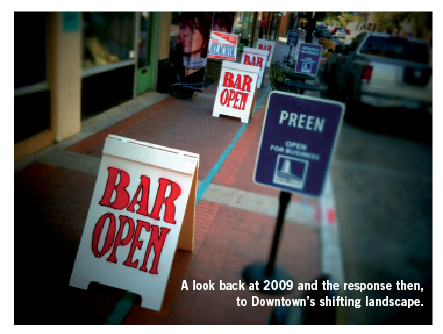
“Bar Open” signs placed along Congress Street, fall 2009.
photo: David Olsen
As we walk by the Rialto Theatre, Good Oak Bar, Diablo Burger, Proper, then Playground, and before peeking into the still under construction Pizzeria Bianco, I have a flashback to 2009.
David Aguirre, Director of Dinnerware ArtSpace—a gallery that had been displaced, along with a couple others, from Congress Street in 2009 when there were initial plans to have Kwang C. An open a restaurant in the 200 block of East Congress Street—had placed several A frames along the sidewalk with the words “Bar Open” on both sides of the signs. It was funny in a prophetic, times are a’changin’ sort of way.
It’s not all bars though, there’s food—HUB and Saint House, though both are known for their cocktails. Across the street there’s Yoga Oasis, Sacred Machine, FORS, Connect Beta, Xoom Juice and Sparkroot. On the next block there’s the Olive Orchard Gourmet Pantry coming to 222 E. Congress St., Buffalo Exchange is there, Studio 220/Got All Your Marbles, Tierra Antigua Realty, Iguana Cafe and Crescent Smoke Shop.
Around the corner and south on 6th Avenue is the forthcoming Johnny Gibson’s Downtown Market in the old Beowulf Alley Theatre space at 11 S. 6th Ave., then there’s The Drawing Studio, Flash in the Past Vintage Pinup Photography Studio, La Fashionista (sharing it’s space with Wig-O-Rama), and Black Rose Tattooers.
Swinging back down to Congress Street, we pass Chicago Music Store and pop into the forthcoming Saint Cecilia Studios—which looks beautifully awesome (see story in last month’s issue). We pass MEB Management and Unplugged Wine Bar; Voodoo Jack’s and Wig-O-Rama sit empty, awaiting restoration due to damage caused by a fire that gutted Grill over a year ago. We look across the street and see, from 6th Avenue to Scott Avenue: Hydra, Empire Pizza, Elliott’s on Congress, The Screening Room, Zen Rock; then, from Scott Avenue to Stone Avenue, JunXion Bar, Jimmy John’s, On a Roll, Sapphire and the upcoming H2O club. Further west, there’s A Perfect Pantry, Lesco Optical, V Thai; from Stone to Church Avenue, the Fox Theatre, Subway, Caffe Milano, Rice House.
Scott Stitler, owner/landlord of the buildings on both sides of the 200 East Congress Street block, said, “Today, I’m not interested in more food,” when talking about what kind of tenants he is looking for to occupy the spaces at 245 E. Congress St. that will become empty once Sacred Machine, and possibly Connect Beta, move out.
Stitler, who also co-owns the Rialto Block with Don Martin, explained that he doesn’t just take any tenant interested in one of his available spaces, he is thorough and selective. “I don’t advertise or put ‘For Rent’ signs in the windows, I’m hyper focused on all three blocks for a good mix, I’m constantly processing all these cities I visit, I travel a lot and take a lot of pictures.
“It’s takes a lot of patience, Pizzaria Bianco is a perfect example. We had 40 or 50 unsolicited offers, and it is tough to manage because you are dealing with nice people, but I was glad I said no on that space, because once Chris (Bianco) came along, and he’s had hundreds of offers to do another Pizzeria Bianco, and after 23 years of saying no, he searched his soul and his soul said yes to Tucson, and this space.”
Stitler said he has had offers on the spaces already, some of them are food, but he’d rather allow the current restaurants to stabilize and he doesn’t want “to add another two or three more.”
“It’s hard on everyone to make it in a month. The short answer is to let some of these projects get further along. Restaurants always lead an area that is getting revitalized, and then you get an office and then an apartment building and so on and so forth. I like where we are from five years ago, and we still have a ways to go, with more housing and more jobs Downtown.”
He paused, and said what is on a lot of people’s minds, “I hope the streetcar is a successful launch.”
The Loop
“The Loop serves as a fantastic car-free multi-use recreational facility, and it’s also a legitimate transportation system that offers great commuting opportunities by connecting nearly every jurisdiction in Pima County.” – Andy Dinauer
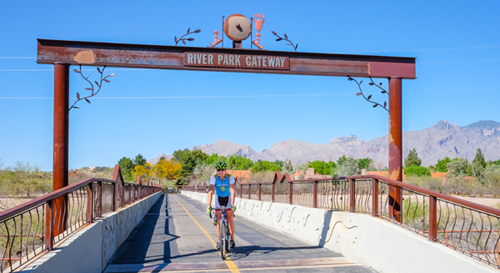
Bridges, like at River Park Gateway, cross washes and display arts,
while providing unparalleled vistas.
photo: Leigh Spigelman
On foot, two-wheels, skates, stroller or horseback, you will find amazing place-making, one mile at a time, along this treasured haunt. The Loop entertains and invigorates all, every day, and it’s one helluva meander.
The city seemingly drops behind when you traverse this interconnection of blacktop, soft sand and gravel paths that hug Pima County’s various river-park systems. While the exact mileage of the linked, Loop-ed trails is a moving target – The main Loop (along the Rillito, Pantano, Julian and Santa Cruz River washes) is approximately 55 miles. With its “fingers” extending up Cañada del Oro wash to Oro Valley, and the Santa Cruz extensions north to Marana and south to San Xavier – this Loop system is more like 130 miles of connected trails.
Engineer Andy Dinauer is the Pima County regional flood control district Division Manager responsible for The Loop projects. His life’s mission is wrapped up in the vision for keeping The Loop accessible…but you’ll need to hustle to keep up with Dinauer, who cycles 120 miles on The Loop each weekend for fun and another 125 miles during each week as part of his daily bike commute.
“The Loop serves as a fantastic car-free multi-use recreational facility, and it’s also a legitimate transportation system that offers great commuting opportunities by connecting nearly every jurisdiction in Pima County,” says Dinauer, who began working on regional watercourse bank stabilization projects in the mid-1980s and has been active in the creation of new Loop segments for the last five years.
Michael McKisson, publisher and editor of the popular TucsonVelo.com cyclist info and advocacy network, agrees that The Loop makes it easier for people around the city to enjoy a car-free place to recreate and transport. “I see The Loop as a gateway,” comments McKisson, who lives along the south bank of the Rillito River. “Many cyclists start on The Loop and graduate to other types of riding including using a bike for transportation.
“When we moved in it was dirt and cyclists were banned, but now it’s open to cyclists and my daughter learned to ride her bike on it,” he adds.
Fueled by Floods
According to Dinauer, Tucson’s river park system, and ultimately The Loop, started as a result of the 1983 floods. Following this disaster, Pima County undertook a tremendous effort to stabilize the banks of the Rillito, Pantano and Santa Cruz Rivers. Included with many miles of bank stabilization installation was the need for a continuous maintenance access route along the top of the channel banks.
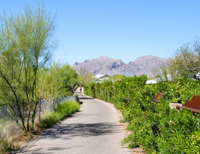
Shaded paths offer green respite and gateways to adjoining neighborhoods.
photo: Leigh Spigelman
“Over time these long linear maintenance access routes evolved from simple dirt trails to the fully improved riverpark segments we see today,” he explains, crediting the County Administrator along with the Pima County Board of Supervisors, the Pima County Flood Control District and Pima County Natural Resources Parks and Recreation with crafting the Loop and riverpark vision that has been systematically implemented over the last 25 years.
“Citizens of every demographic can enjoy it,” adds Michael Woodward, founder of Michael Recruits talent recruitment agency who recently moved here from Seattle. “Because it covers so much of Tucson, The Loop is a great socioeconomic connector and sets Tucson apart from other cities.”
Refresh and Ramble
The Loop system incorporates many rest stops as well as places to see the artistry, and Pima County’s trail system map, updated in January, outlines the amenities as well as the paths.
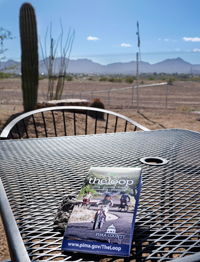
A table outside of Tucson’s Loop Bicycle Shop, where they extends repairs and special amenities off the Santa Cruz sector.
photo: Leigh Spigelman
One entrepreneurial must-see spot sits along the Santa Cruz route, just north of West El Camino Del Cerro. Tucson’s Loop Bicycle Shop, 3201 W. Diamond St., is an oasis co-founded by Michael Wilkinson along with Sonoran Landscaping owner Robert McLoy. Operating since 2012 out of a metal storage unit just off The Loop along the back side of the Sonoran rock and gravel biz – this respite offers grand vistas as well as bike mechanics, gear, coffee and cold drinks, energy snacks, various local products and very clean restrooms. On weekends and select weekdays, there’s also entertainment and more eats, including Tommy’s On the Road café/food truck, which cooks up breakfast, subs and other dishes.
Dotting The Loop are other interesting rest spots and parking areas. For example, on the south bank of the Rillito just east of Alvernon Way, one station offers crafted flagstone lounge furniture. Near Sweetwater Wetlands, recent path improvements on the east bank of the Santa Cruz between Grant and El Camino Del Cerro also offer a rest area with leaf-themed bike racks, a wildlife themed bench and a decorative trash can.
While each Loop segment has its distinct quality, the granddaddy of them all is the promenade along Rillito. Also the site of the most recent Loop improvements, the Rillito’s north bank path from Campbell to La Cholla (4.5 miles) was just widened and resurfaced. Dinauer notes that this section was the oldest (late 1980s vintage), narrowest and most congested section, and it was long overdue for its facelift, completed in March.
Path Picks
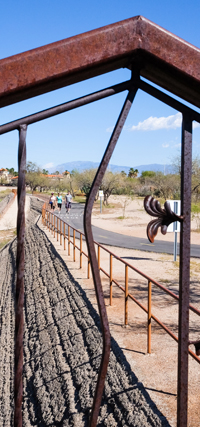
The Loop extends to the washes, with entries for close-to-nature and equestrian enjoyment.
photo: Leigh Spigelman
With The Loop being a center of gravity for so many, a crossover appeal has emerged, as walkers mix it up with cyclists, who hum alongside joggers, stroller-pushers, dog walkers and septuagenarians. There are unique vistas, eclectic artwork, parks and even historical buildings collected along the natural necklace of trails. There’s the Garden of Gethsemane and the artistic Luis G. Gutierrez Bridge/Cushing Street bridge in the southwest, the Fantasy Island Mountain Bike trails park in the southeast (note: sections here still planned or under construction), and access to Binghampton Rural Historic District to the north. Freestyle BMX riders, sports enthusiasts, hill climbers and soccer players can check the map for additional unique offerings all accessible via The Loop.
Everyone has their favorite route. Dinauer tends to frequent the Santa Cruz and Rillito segments. “During the winter months I probably spend more time on the Santa Cruz because of the abundance of sunshine while in the heat of the summer the Rillito offers some very shady corridors on its many tree-lined sections.”
Velo’s McKisson pinpoints another Rillito spot as his favorite. “There is a section of The Loop on the north side between La Cholla and La Cañada where the trees make a kind of tunnel.”
For Woodward, his favorite section starts at Swan and River, with its parking area and small park, which allows him to travel across the washes in extended directions: “I love the bridges and the vistas they provide – heading north from Swan and River you can go off the tar path and walk the trail, experiencing the wildlife. I also love the River Park Gateway Bridge (just east of Rillito Raceway Park) that lets you cross over the wash.”
Future Talk
Ongoing are Pima County’s plans for interactive mobile mapping applications as well as completion of missing links on The Loop. Two hoped-for 2015 improvements skirt the Pantano Wash (from Craycroft Road to Tanque Verde Road) and the Harrison Greenway (which links the Pantano and Julian Washes).
Dinauer also mentions the Paseo de las Iglesias Phase I (a Santa Cruz river bank protection, ecosystem restoration and creation of a seven-mile linear parkway, along Ajo Way and Silverlake Road), as an active Loop project, with others in the planning stages.
“I think The Loop’s success should tell government officials that people really want a safe and separated bike infrastructure, not just looping around the region, but right though the middle of it too,” observes McKisson. “I’d also like to see more linear parks within the city limits that connect to the outer loop.”
Woodward adds his hopes for more access points, even a Streetcar connection. “There are whole sections off River and Sabino that can’t be accessed unless you live in a development that backs up to the path,” he says. “Another idea would be to have dedicated paths from The Loop connecting to spots where you can catch the Streetcar, really creating a car-alternate route for commuters.”
So many possibilities for The Loop to fulfill Tucson’s sustainability vision, and connect community to its soul. The adage asks: Is it the journey or the destination? When you explore The Loop’s many dimensions, you discover it may be a little of both.
More information is available at Webcms.Pima.gov/Government/The_Loop/.
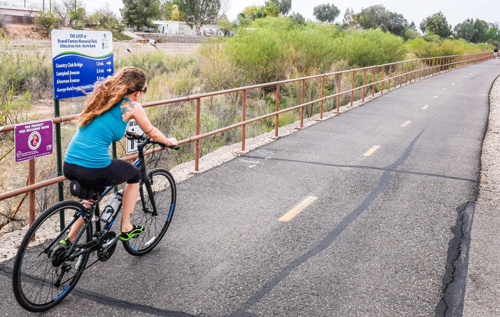
The Rillito is the oldest stretch, with recent renovations widening
and resurfacing 4.5 miles of this trail way.
photo: Leigh Spigelman
Summertime Companion Planting
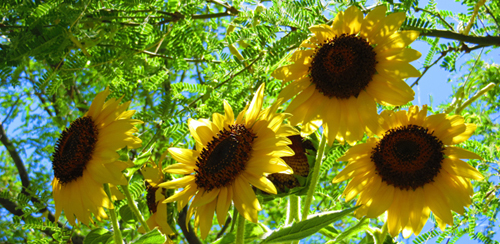
Sunflowers make great summer garden plants as they provide a source of shade for plants growing beneath them.
photo: Amber Merchant
What is Consciousness?
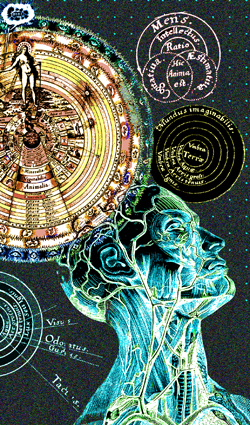
Illustration by Pop Narkotic
The question—as fundamental and mysterious as any in the universe—intrigues an array of scientists and philosophers today as it has for centuries.
Scientists, philosophers, researchers, scholars, artists, students and humanists from around the world will convene in Tucson this month to speak, listen, discuss, debate and present their ideas on the exact nature of consciousness.
The 2014 Toward A Science of Consciousness is the 20th anniversary of the landmark conference in Tucson that kicked off a new era of studies on the subject. The conference will reflect on the two decades of progress and dilemmas, current research and includes a “who’s who” list of presenters, including spiritual author/alternative medicine/holistic health guru Deepak Chopra, M.D., and world-renowned physicist and mathematician Sir Roger Penrose.
“Consciousness was kind of banned from science for most of the 20th century,” says Dr. Stuart Hameroff, director of the UA’s Center for Consciousness Studies. “William James popularized consciousness in psychology, but the behaviorists took over psychology and what became acceptable was anything you could measure. You can’t really measure consciousness, so consciousness became a dirty word for most of the 20th century and wasn’t really a scientific consideration.”
Hameroff, Professor Emeritus in the UA Departments of Anesthesiology and Psychology, says the scientific study of consciousness—after being spurned for so many years—emerged again in the late 1980s. Eminent scientists like Francis Crick, Penrose and others began seriously addressing consciousness, publishing books on the subject and giving it a renewed scientific acceptability.
At first relegated to the realms of very particular fields in inquiry, consciousness studies began crossing and combining disciplines and competing views emerged. The viewpoints closely aligned with ancient philosophical approaches, one more Western in describing consciousness as a by-product of brain activity and one more Eastern in considering consciousness a primary basis for reality.
“There are two basic camps, one is the brain as a computer and the second is that the brain connects our thoughts to the fundamental level of the universe,” Hameroff says. “Both of these views have come a long way (since the 1994 conference).”
Though consciousness began moving into the scientific mainstream, prior to 1994 there were only conferences with specific focus—for example on philosophy of mind, Hindu spiritual approaches, neuroscience or artificial intelligence.
“It wasn’t until our conference in 1994 that you saw an integrated approach,” Hameroff says. “You bring everybody together under one umbrella and try to break down these barriers. That first was very successful. It was phenomenal experience that galvanized the interdisciplinary approach.”
Planning the initial 1994 conference, Hameroff and his UA colleagues Alfred Kaszniak in psychology, the late Alwyn Scott in mathematics and then conference manager Jim Laukes, didn’t know what to expect. The Internet had just begun connecting scientists and philosophers from around the globe and suddenly those shared interests could be explored free from geographic boundaries.
Hameroff describes a then-unknown philosopher, Australian David Chalmers, setting the tone. Chalmers, an Oxford-educated philosopher then a professor at the University of California-Santa Cruz, framed consciousness in just the right terms.
“He talked about how problems like memory, learning, attention and behavior were relatively easy compared to the really hard problem of how and why we have conscious experience,” Hameroff says. “We could have been non-conscious, robot-like zombies with no inner life. So how and why do we have feelings and awareness? That was the hard problem and at that moment, we knew why we were there.”
After the 1994 conference, there was great demand for a follow-up and the UA began hosting the conference every other year, helping to sponsor the off-year conferences at other sites around the world, in places such as: Naples, Italy; Tokyo, Japan; Copenhagen, Denmark; Stockholm, Sweden, among many other locales.
In 1998, with a grant from the Fetzer Institute, the UA’s Center for Consciousness Studies began, with Chalmers recruited to join the philosophy department and serve as the center’s director. Chalmers, who became the UA’s youngest-ever Regents’ Professor before returning to Australia, returns as a featured speaker for this year’s conference.
Hameroff, who continues a collaboration he began with Penrose at the 1994 conference on a well-known but controversial quantum theory of consciousness, says breakthroughs in quantum brain biology have them on the verge of catching up to the computationalists.
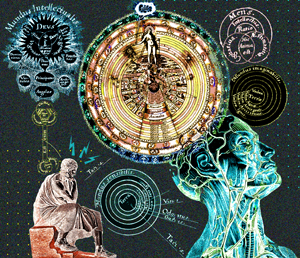
Illustration by Pop Narkotic
“Consciousness is a fundamental, irreducible part of the universe,” Hameroff says in describing his theory. “Rather than consciousness being a property of a particle, it’s a property of the fabric of the universe. The idea is that consciousness is intrinsic to the universe and it’s built into the universe, it’s ubiquitous, it’s everywhere and what the brain does is organize it.”
As far as the science, Hameroff says both approaches have seen great progress in the 20 years since the initial conference. Major strides in brain mapping join the advances in quantum mechanics in spurring on the competing views in their own ways and continuing to build excitement for consciousness as a field of study.
The conference—from Monday, April 21 to Saturday, April 26—is expected to draw 800 scientists, philosophers, experientialists, artists and students from more than 60 countries to the University Park Marriott Hotel, 880 E. 2nd St. Seating is limited and registration is required. In addition to the keynote, Penrose will also give a public talk on astrophysics on April 21 at the UA’s Steward Observtory, 933 N. Cherry Ave.
The conference will feature presenters on both sides of the quantum-computational divide, as well as discussions of subjectivity and objectivity, near-death and out-of-body experiences, Eastern spiritual approaches, mind uploading and a revisiting of Chalmers’ “hard problem.”
Just as the Toward a Science of Consciousness conference made its mark on the world 20 years ago, this year’s version promises to define the leading edges of consciousness studies for the next decades of breakthroughs. And, Hameroff says, the UA’s prominent role in the field continues to draw global attention.
“What the future will bring, we don’t know,” Hameroff says. “Certainly in an interdisciplinary way, the conference and our center did put the University of Arizona on the map in terms of consciousness studies around the world. Ironically, on campus we’re not all that well appreciated. But worldwide, we’re very well known.”
The conference runs from Monday, April 21 to Saturday, April 26. Registration fees are $450-$550, with additional costs for workshops and other activities. For more information, visit Consciousness.arizona.edu.
Tidbits
Jazz Performances @ Main Gate Square
Whether you are a jazz buff or someone interested in live entertainment, the concerts Southern Arizona Arts and Cultural Alliance are hosting this month are sure to inspire. The shows take place at Main Gate Square on April 4 and April 18 at 7 p.m. in Geronimo Plaza, 814 E. University Blvd.
The UA Studio Jazz Ensemble—comprised of the most prestigious student musicians from the university— perform on April 4. The ensemble earned the UA Global Excellence Award in 2013 after showing off their talents in two tours through China. The April 18 concert features soul, jazz and R&B vocalist Crystal Stark. A graduate from the University of Arizona, Stark later made it into the top 44 contestants in the fifth season of American Idol. Parking is free after 5 p.m. in the Tyndall Garage, 880 E. 4th St.
For more information about the concerts, visit SAACA.org, MainGateSquare.com or call (520) 797-3959.
Ethan Bortnick, 13-year-old protégé, Performs in Tucson
World-known musician and humanitarian Ethan Bortnick is performing at Pima Community College’s Proscenium Theatre, 2202 W. Anklam Rd., on Saturday, April 5 at 7 p.m. At only 13-years-old, Bortnick has performed with stars like Elton John and Santana, holds the Guinness World Record for youngest musician to tour solo, and has raised more than $30 million for charity.
During the concert, Bortnick will cover classic pop tunes from artists like Michael Jackson, The Beatles, and Elton John. His performance will also feature songs he composed that are in his newly released movie, Anything is Possible. Bortnick will also engage audience participation with a Q&A and improvisational segments.
Tickets cost $39 each, and may be purchased at EthanBortnick.com/PowerOfMusicTV.
Sam Hughes Garden Tour
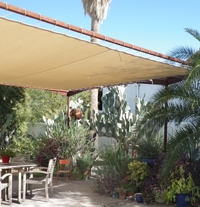
Seven private Sam Hughes homes are opening up their gardens to the public on Sunday, April 6 from 10 a.m. to 4 p.m.
photo courtesy Sam Hughes Neighborhood Association
Seven private Sam Hughes homeowners and two public properties are opening up their gardens for the public to admire on Sunday, April 6 from 10 a.m. to 4 p.m.
The two-mile, self-guided tour through the historical neighborhood offers attendees a chance to check out outdoor architectural decorations, sculptures, a certified wildlife habitat garden, a backyard chicken coop, and a hummingbird garden. The neighborhood’s phenology trail, which shows the progression and changes of plant and animal life over time, will also be open to onlookers.
Tickets are $10 for adults, and entry is free for children. Tickets may be purchased between 10 a.m. until 1:30 p.m. the day of the tour at the Inner Courtyard of Sam Hughes Elementary School, 700 N. Wilson Ave. Parking for the tour is free, and can be found around the neighborhood.
Visit SamHughes.org for more information.
Pennington Street Block Party
From April 11-13, Tucson Service Learning Group is hosting the 26th Global Youth Service Days: an international community service event held in over 100 countries that celebrates youth’s contributions to society.
The Pennington Street Block Party, coordinated by City High School and the Girl Scouts of Southern Arizona, will kick off the international campaign for community change from 4 p.m. until 7 p.m. on Friday, April 11. The event happens along Downtown’s Pennington Street, between Stone and Scott Avenues.
At 4 p.m., the block party will hold a ceremony where the Ray Davies Student Service Award will be presented to an all-around honorable student. To receive the award, mentors nominate students who have a finely tuned sense of community, while demonstrating leadership and compassion for others. The award was named after the reputable Human Relations Commission member, Ray Davies. Other activities include: musical performances, teaching demos, interactive booths, street theater, art exhibits, carnival games, and more.
For more information about the event, visit CityHighSchool.org, TucsonSLG.org and GYSD.org.
Sink Your Roots into Sonoran X
 Plant lovers unite for the Tucson Cactus & Succulent Society’s Sonoran X Conference! This year’s theme is “Plants for the Sonoran Desert Hobbyists,” a showcase of unique cacti and hybrid plants from around the world. The plant conference is on Saturday, April 19 from 8 a.m. until 9 p.m. and Sunday, April 20 from 8 a.m. until 3:30 p.m. at 475 N. Granada Ave.
Plant lovers unite for the Tucson Cactus & Succulent Society’s Sonoran X Conference! This year’s theme is “Plants for the Sonoran Desert Hobbyists,” a showcase of unique cacti and hybrid plants from around the world. The plant conference is on Saturday, April 19 from 8 a.m. until 9 p.m. and Sunday, April 20 from 8 a.m. until 3:30 p.m. at 475 N. Granada Ave.
Registered attendees will get a glimpse of grandeur member collections, participate in workshops, listen to five guest speakers, and enjoy two lunches and a dinner. The $50 registration takes place in the lobby from 8 a.m. until 5 p.m. on Saturday, and from 8 a.m. until noon on Sunday. Attendants who do not wish to register will still have access to the plant showings, a silent auction and the pottery, book, art and plant sales.
For more information about the conference and how to register, visit TucsonCactus.org or call (520) 256-2447.
Earth Day $1 Sale
Another segment of Buffalo Exchange’s 40th anniversary celebrations include its Earth Day Dollar Sale on Saturday, April 19. All 49 Buffalo Exchanges nationwide will raise proceeds from $1 ticket items and donate the funds directly to Tucson’s Arizona-Sonora Desert Museum.
Last year, the event raised a total of $43,000, which was donated to the Humane Society. This year’s funds will go to supporting and preserving the outdoor living museum’s “Pollination Hotspots” program. The program works to conserve, sustain and analyze the variation of seed production levels across the Sonoran Desert.
For more information about the museum and Buffalo Exchange, visit DesertMuseum.org and BuffaloExchange.com.
Tucson’s First Open Water Swim Triathlon
5430 Sports has coordinated Tucson’s first open water triathlon: Welcome, the 5430 TriZona Triathlon, happening on Sunday, April 27. Participants will face a 3.5 mile run, a 14.5 mile bike ride and 750 meter swim in the 10-acre Kennedy Lake. (Turner Labs discovered the water flowing into Kennedy Lake to be safe for not only swimming, but also drinking, according to 5430Sports.com.) Swimmers will begin the initial “wave,” or one lap swim, at the southeast corner of the lake. They will then head clockwise and finish at the southwest corner, where they will strip their wetsuits and start the run.
The first, second and third place winners from each age group will be awarded hand-made trophies. Registration for the triathlon is $90 if purchased by April 25.
For more information about the triathlon and how to enter, visit 5430Sports.com/TriZona.
April’s Bicycle Hullabaloos
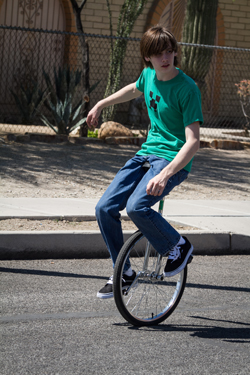
Cyclists of all ages and abilities participate in Cyclovia.
photo: Kathleen Dreier/Esens Photography
Paolo Soleri, the architectural mastermind often credited as the grandfather of sustainability, saw the city as earth’s newest organism. More accurately, he called the city a “hyperorganism,” meaning that it exhibits traits of a living thing (consuming materials, putting out waste, supporting the lives of smaller organisms), but that it lacks the self-governing mechanisms (like a brain) that are available to truly organic things. To Soleri this meant one of two things for cities in general—either a transition to hyper-organization, or degradation into chaos. And by choosing to become so reliant on the automobile to get around our cities, Soleri would say we have been choosing chaos for nearly a century.
“What has been happening in the last few generations,” Soleri said in a 2012 talk to students at his famous experimental city, Arcosanti, Arizona, “is that we are no longer persons, but we are car persons. Because the car has become such a familiar part of the family, an indispensable presence in our lives, we are not separable from the car itself… we have accepted the motorized hermitage of a person in a car.”
Enter the Living Streets Alliance (LSA). According to Kylie Walzak, event coordinator for Cyclovia Tucson (a project of LSA’s Bike Fest), LSA is “Tucson’s non-profit organization working toward a more sustainable city and safer, more people-oriented street design.”
This April marks the fifteenth year of Tucson’s annual Bike Fest, which started in 1991 as “Bike to Work Week,” but has evolved over time into the month-long celebration of all things pedal-powered that it is today.
“The festival is not about the bicycle as much as it is about imagining what our streets could look like if we allowed equal access to them,” says Walzak. “Right now they’re very dominated by one type of transportation—the personal vehicle… Our streets are public spaces but they’re not publicly accessible to everybody.” Walzak explains that taking cars off of the road and opening the streets up to safe bicycle and pedestrian traffic “humanizes (a) landscape that’s often dominated by the loud noise and fast pace of cars.”
And that’s just what the organization is doing.
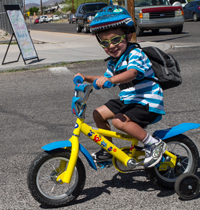
Cyclists of all ages and abilities participate in Cyclovia.
photo: Kathleen Dreier/Esens Photography
Twice a year, LSA takes over a loop of pavement in either Downtown or midtown Tucson for the bi-annual Cyclovia event, which makes the vision of public streets imagined by the likes of Soleri and Walzak a reality, at least in microcosm. Modeled after similar events that have become extremely popular in places like Bogotá, Columbia (Cyclovia comes from the Spanish ciclovia, or “cycle street”), this spring’s affair will link the neighborhoods of Downtown and South Tucson with a roughly 10-mile corridor of car-free roads.
Perhaps the most exciting part of Cyclovia 2014 is the fact that two independent music festivals are flanking the north and south ends of the loop along South Sixth and South Fourth Avenues. To the north, Armory Park hosts the first ever Tucson Hullabaloo—a Flagstaff transplant that has been voted Best Annual Event by Flagstaff Live! (a weekly alternative magazine) four-years running, and to the south, the City of South Tucson stages a mini-revival of their Norteño Music Festival at Tucson Greyhound Park with Feria De Sur Tucson.
Though Cyclovia is undeniably the pinnacle of Bike Fest, events will be held throughout the month of April in observance of the festival. Walzak says, for instance, that the folks behind the local Tuesday Night Bike Rides are putting on a bike-in movie series in secret locations throughout the city only accessible to non-motorized modes of transportation, and the two-mile commuter challenge will run citywide the entire month long.
Ann Chanecka, bicycle and pedestrian coordinator for the City of Tucson, says that an estimated 43 percent of all trips (yes, that means ALL trips) are less than two miles long, and that a whopping 85 percent of those trips are still made by car—a fact she attributes largely to a lack of bicycle accessibility in the city. She says that, in addition to the $5.5 million put into bicycle and pedestrian infrastructure last year, the City of Tucson is poised to invest another $5 million this year, including the installation this summer of Tucson’s first physically protected bike lane, along St. Mary’s Road between I-10 and Main Street. By making bike lanes safer and getting more of its citizens on bicycles, the goal is to take Tucson’s community rating from the Legion of American Bicyclists from Gold to Platinum—a designation shared by only four cities nationwide.
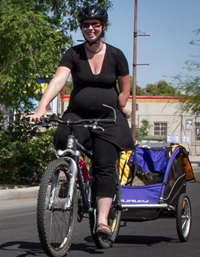
photo: Kathleen Dreier/Esens Photography
Even Mayor Jonathan Rothschild is weighing in on the importance of bicycles to our community—he’s agreed to join in on the two-mile commuter challenge himself, for one. He says that, not only are alternative modes of transportation like bicycling and walking great for the environment, making bike safety and accessibility a priority in Tucson will help supplement the local economy. In addition to their obvious appeal to cycle-loving tourists and as an alternative source of transportation, Mayor Rothschild says that tech companies are looking to associate their businesses with bike friendly towns. “We have found, and studies have shown, that the folks that are going to be the economic drivers of the next generation… love bicycling and want to be in communities where there is a strong bike ethic,” says the Mayor.
Mayor Rothschild is also quick to talk about the personal benefits of stepping away from your car once-in-a-while: on a bike, he says, “you really get to know your city better… life moves just a little slower, although not much slower, but slow enough to where you notice [things in] your neighborhood” you might otherwise have missed.
Perhaps that’s why bikes seem to be making such a strong resurgence as a primary mode of getting from A to B—says Walzak, “it’s fair to say that the bicycle has reached mythical proportions in terms of marketing and cool cachet.”
If only that were true when I was in high school.
Bike Fest is ongoing throughout the month of April. More info at BikeFestTucson.com. Cyclovia takes place on April 6 from 10am-3pm, CycloviaTucson.org. Feria De Sur Tucson runs concurrently with Cyclovia and is free to attend, see FeriaDeSurTucson.com. Tucson Hullabaloo, TucsonHulla.com, runs April 5-6 from 10am-9pm on Saturday, 10am-8pm on Sunday. Tickets are $5 or free to the first 500 people with two cans of food.

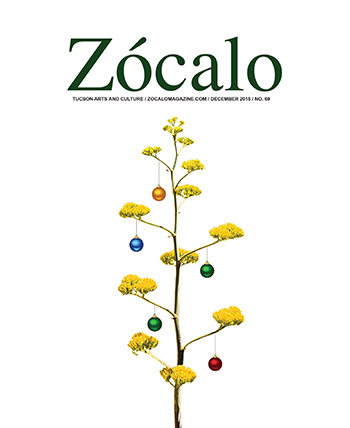




Also find us on...